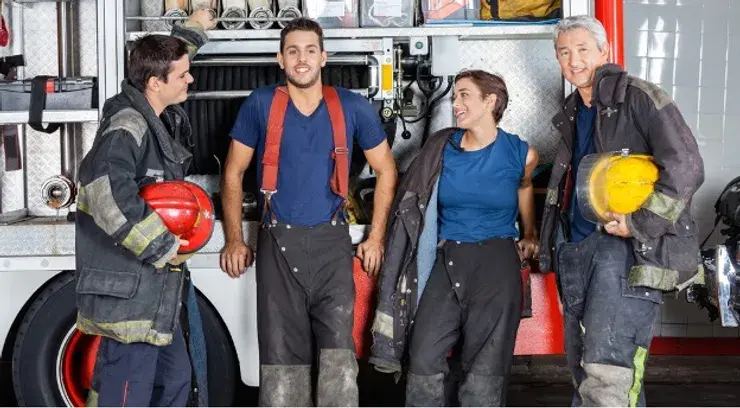In the brave and selfless world of firefighting, where heroes rush headlong into danger to protect lives and property, a silent crisis is unfolding. Behind the courageous façade lies a growing epidemic that demands our urgent attention: firefighter suicide.
As we celebrate the valor and resilience of these first responders, it is imperative to shed light on the profound mental health challenges they face — and what can be done to address these challenges.
This article delves into the disturbing trend of rising suicide rates among firefighters, exploring the unique stressors that contribute to this crisis and the critical need for a collective effort to address the mental well-being of those who dedicate their lives to our safety.
According to the U.S. Department of Health in a supplemental by the Substance Abuse and Mental Health Administration:

Table of Contents
- Firefighter Suicide Statistics: Why Firefighter Suicide Is More Critical Than Ever
- Preventing Firefighter Suicide
- Siento: Promoting Firefighter Suicide Prevention Through Peer Support
Firefighter Suicide Statistics: Why Firefighter Suicide Is More Critical Than Ever
Firefighter suicide is a critical and pressing issue that has gained increased attention in recent years. Several factors contribute to the growing concern surrounding the mental health of firefighters, and understanding these elements is crucial for addressing the problem effectively. A growing body of evidence suggests that firefighters are at higher risk of committing suicide when compared to their civilian counterparts.
According to the U.S. Department of Health in a supplemental by the Substance Abuse and Mental Health Administration:
“It is estimated that 30 percent of first responders develop behavioral health conditions including, but not limited to, depression and [PTSD], as compared with 20% in the general population. In a study about suicidality, firefighters were reported to have higher attempt and ideation rates than the general population.”
According to the Firefighter Behavioral Health Alliance:
- 57.6% of firefighters report having experienced a major Morally Injurious Event, like injured children or evidence of abuse.
- 49.8% admitted to feeling emotionally detached and isolated, long recognized as a mental-health stressor.
- From 2014-2020, more firefighters died by suicide than in the line of duty.
A white paper commissioned by the Ruderman Family Foundation has revealed that:
“First responders (policemen and firefighters) are more likely to die by suicide than in the line of duty. In 2017, there were at least 103 firefighter suicides and 140 police officer suicides. In contrast, 93 firefighters and 129 police officers died in the line of duty.”

Knowing When To Get Help
Recognizing the signs that you may need help is crucial in the prevention of self-harm and suicide. If you are experiencing any of the following warning signs, it’s critical that you seek help immediately:
- Persistent negative thoughts or frequent thoughts of death or suicide.
- Avoidance of social interactions and withdrawal from friends and family.
- Noticeable changes in sleep patterns or drastic changes in appetite.
- Frequently talk about saying goodbye or giving away possessions.
- Expressing feelings of being a burden to others.
- Extreme mood swings, from deep despair to sudden calmness.
- Persistent feelings of overwhelming sadness or unexplained rage.
- Increased reliance on drugs or alcohol as a means of coping.
- Escalation of substance abuse despite negative consequences.
- Neglecting personal hygiene or showing disregard for well-being or personal grooming.
- Actively seeking access to lethal means, such as firearms or medications.
- Researching methods of self-harm online.
- A history of suicide attempts, self-harming behaviors, or previous instances of expressing the desire to die.
- A sudden and unexpected sense of calm or relief may indicate a decision to end one’s life.
If you or someone you know needs immediate help for suicidal thoughts, call the National Suicide Prevention Lifeline in the U.S. at 1-800-273-TALK (8255) or dial 9-8-8 in Canada.
How To Help Someone in Crisis
If you believe someone is considering suicide, it's crucial to take immediate action to help and support them. Here are some steps you can take:
- Take it seriously: Always take talk of suicide seriously. Avoid dismissing their feelings or minimizing the situation.
- Listen with empathy: Encourage the person to talk openly about their feelings. Be non-judgmental, and listen with empathy. Allow them to express their emotions without interruption.
- Ask direct questions: Ask direct questions about suicide without being confrontational. For example, you might ask, "Are you thinking about hurting yourself?" This can help clarify their intentions and reduce suicidal ideation.
- Encourage professional help: Encourage the person to seek professional help from a mental health provider, counselor, or therapist. Offer to help them find and schedule an appointment.
- Offer support: Let the person know that you care and are there to support them. Reassure them that they don't have to face their struggles alone.
- Remove immediate danger: If there's an immediate threat, help the person remove any means of self-harm or lethal methods from their immediate environment.
- Stay with them: If possible, stay with the person or encourage them to be with someone they trust. Avoid leaving them alone if you are concerned about their safety.
- Call emergency services: If the risk is imminent, do not hesitate to call emergency services (911 in the United States or Canada or the appropriate emergency number in your country). Report the situation and follow their guidance.
- Reach out to friends and family: Involve other friends, family members, or support networks. Building a supportive community around the person can provide additional assistance.
- Encourage them to connect: Encourage the person to connect with their support network, whether it's friends, family, or community resources.
- Follow up: Continue to check in on the person regularly. Follow up to ensure they are receiving the help they need and that their situation is improving.
Remember, helping someone in crisis is a serious matter, and it's important to involve professional help when needed. If you are unsure how to handle the situation, consult with mental health professionals or crisis helplines for guidance.
If you or someone you know needs immediate help for suicidal thoughts, call the National Suicide Prevention Lifeline in the U.S. at 1-800-273-TALK (8255) or dial 9-8-8 in Canada.

Preventing Firefighter Suicide
Preventing firefighter suicide requires a comprehensive and proactive approach that addresses the unique challenges faced by these first responders.
By proactively addressing mental health, providing resources, and fostering a culture of support, the firefighting community can work collectively to prevent firefighter suicides and prioritize the well-being of those who dedicate their lives to public safety.
10 Steps That Can Be Taken To Reduce Firefighter Suicide Rates
#1: Mental Health Awareness
Mental health awareness can help prevent firefighter suicide by destigmatizing mental health issues, encouraging open communication, and promoting early intervention.
It creates a supportive environment where firefighters:
- Feel comfortable seeking help
- Recognize signs of distress in themselves and their colleagues; and
- Access the necessary resources and support systems to address and manage mental health challenges effectively
#2: Training and Education
Implement comprehensive mental health training programs for firefighters, focusing on awareness, coping mechanisms, and recognizing signs of distress in themselves and their peers.
Incorporate suicide prevention education into the training curriculum for firefighters, educating them on risk factors, warning signs, and steps to take when someone is in crisis.
#3: Access To Mental Health Services
Access to mental health services helps prevent firefighter suicide by providing timely and confidential support. Firefighters can proactively address stress, trauma, and mental health challenges, reducing the risk of suicide.
Professional assistance enables early intervention, coping strategies, and ongoing mental health care, fostering resilience and well-being within the firefighting community.
#4: Stress Reduction Programs
Equipping firefighters with effective coping mechanisms, promoting emotional well-being, and reducing the cumulative impact of occupational stressors may help prevent suicide ideation.
These programs may lower the risk of suicide within the firefighting community by:
- Enhancing resilience
- Mitigating burnout; and
- Contributing to a healthier mental state
#5: Critical Incident Stress Management (CISM)
Critical Incident Stress Management (CISM) programs provide structured support after traumatic events. It allows firefighters to process and cope with the emotional impact of critical incidents, reducing the risk of long-term trauma.
By addressing immediate stressors, CISM contributes to mental well-being and helps prevent the development of suicidal thoughts or behaviors among firefighters.
#6: Work-Life Balance
Adequate time for rest, leisure, and personal life activities can:
- Contribute to emotional resilience
- Mitigate the impact of stressors; and
- Enhance mental health
A balanced lifestyle can be a protective factor against the development of mental health challenges that may lead to suicidal thoughts or behaviors among firefighters.
#7: Regular Mental Health Check-Ins
Regular mental health check-ins create opportunities for early intervention. Firefighters can openly discuss their emotional well-being, stressors, and concerns, allowing for timely support and resources.
These check-ins contribute to a supportive culture, reduce the stigma surrounding mental health, and address potential risk factors before they escalate.
#8: Cultural Shift
When the workplace culture promotes well-being and supports those facing mental health challenges, firefighters are more likely to seek assistance, reducing the risk of suicide and creating a resilient and supportive community.
#9: Crisis Hotlines and Resources
By providing immediate, confidential support, crisis hotlines offer a lifeline to firefighters facing distress. It allows firefighters to access professional assistance, talk through challenges, and receive guidance on coping strategies.
These crucial resources offer timely intervention and may contribute to the overall mental well-being of firefighters, reducing the risk of suicide.
#10: Peer Support Programs
By creating a peer-to-peer network of understanding colleagues who can offer empathy, share experiences, and provide a sense of community, firefighters may be more likely to open up and share their feelings.
Having peers trained in mental health support allows for early intervention, reducing feelings of isolation, and fostering an environment where firefighters feel comfortable seeking help, ultimately lowering the risk of suicide within the firefighting community.
Siento: Promoting Firefighter Suicide Prevention Through Peer Support
At Siento, we recognize the need for peer-to-peer support for firefighters. Not only do first responders experience a unique set of challenges and traumas, but most of what’s encountered in the field may not be fully understood by anyone outside of the firefighter community.
At Siento, our mission is to address the mental health stigma within the firefighter community and build a safe and non-judgmental space for anyone in high-stress industries to share their struggles.
We believe the pervasiveness of firefighter suicide can be addressed and minimized through destigmatizing mental health issues and access to mental health resources and peer-to-peer support programs.
For more information about joining our peer support community, click here.

If you or someone you know needs immediate help for suicidal thoughts, call the National Suicide Prevention Lifeline in the U.S. at 1-800-273-TALK (8255) or dial 9-8-8 in Canada.
The content in this blog is not intended to be a substitute for professional medical advice, diagnosis, or treatment. Always seek the advice of your physician or other qualified health provider with any questions you may have regarding a medical condition.








